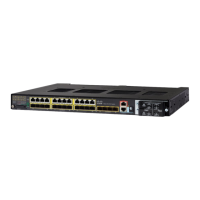833
Configuring IP Unicast Routing
Configuring OSPF
DETAILED STEPS
Use the no form of these commands to remove the configured parameter value or to return to the default value.
EXAMPLE
The following example mandates authentication for areas 0 and 10.0.0.0 of OSPF routing process 201. Authentication
keys are also provided.
interface ethernet 0
ip address 192.168.251.201 255.255.255.0
ip ospf authentication-key adcdefgh
!
interface ethernet 1
ip address 10.56.0.201 255.255.0.0
ip ospf authentication-key ijklmnop
!
router ospf 201
network 10.0.0.0 0.255.255.255 area 10.0.0.0
Command Purpose
1. configure terminal Enter global configuration mode.
2. router ospf process-id Enable OSPF routing, and enter router configuration mode.
3. area area-id authentication (Optional) Allow password-based protection against
unauthorized access to the identified area. The identifier can
be either a decimal value or an IP address.
4. area area-id authentication
message-digest
(Optional) Enable MD5 authentication on the area.
5. area area-id stub [no-summary] (Optional) Define an area as a stub area. The no-summary
keyword prevents an ABR from sending summary link
advertisements into the stub area.
6. area area-id nssa [no-redistribution]
[default-information-originate]
[no-summary]
(Optional) Defines an area as a not-so-stubby-area. Every
router within the same area must agree that the area is
NSSA. Select one of these keywords:
no-redistribution—Select when the router is an NSSA
ABR and you want the redistribute command to import
routes into normal areas, but not into the NSSA.
default-information-originate—Select on an ABR to
allow importing type 7 LSAs into the NSSA.
no-redistribution—Select to not send summary LSAs
into the NSSA.
7. area area-id range address mask (Optional) Specify an address range for which a single route
is advertised. Use this command only with area border
routers.
8. end Return to privileged EXEC mode.
9. show ip ospf [process-id]
show ip ospf [process-id [area-id]]
database
Display information about the OSPF routing process in
general or for a specific process ID to verify configuration.
Display lists of information related to the OSPF database for
a specific router.
10. copy running-config startup-config (Optional) Save your entries in the configuration file.

